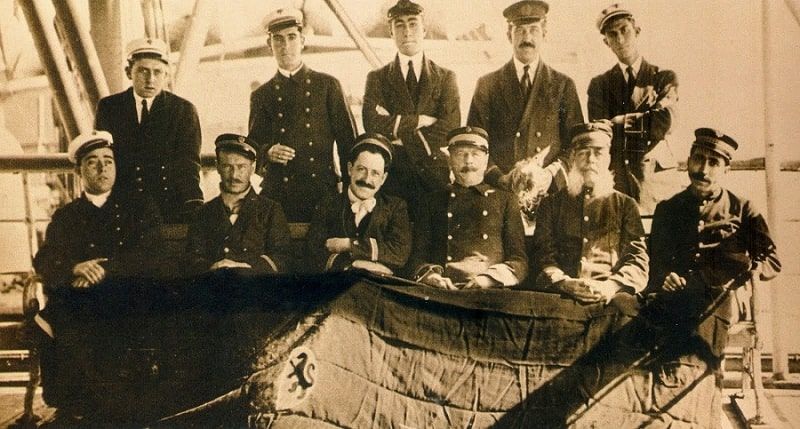100 years without answers about the Valbanera shipwreck
The wreck of the ship, in which 448 people perished, remains unexplored 12 meters under the sea, "guarded" by the sharks and barracudas that populate the area of the Atlantic where it sank.

The appearance of the wreck of the steamship Valbanera, sunk 12 meters deep off the Florida Keys, with all the lifeboats in place and without any remains of the 488 people on board, has turned the largest shipwreck of the Spanish merchant navy into a mystery about which even today, 100 years after its sinking in September 1919, there are still many unanswered questions.
Practically all the passengers of this ship, a 122-meter long cargo vessel with a capacity for 1,142 passengers and 88 crew members, were Spanish emigrants on their way to Cuba in search of work. After a month's voyage - the ship left Barcelona on August 10, 1919 - it arrived at its destination, Havana, on September 9. That day, the storm prevented her from entering the port and it was the last time she was seen floating on the sea. From then on, absolute silence. There was no more news about the Valbanera, nor was any message received from the ship, until 10 days later, on September 19, the American submarine hunter US SC203 found her remains at a depth of 12 meters in an area known as "Half Moon Bank", almost 200 kilometers from her destination.
The diver who dived to check the wreck was able to verify that it was the Valbanera -its name was perfectly legible on the hull-; but of the people on board, 488 passengers and crew, he did not find a single trace, nor any indication that they had tried to use the lifeboats to escape from the wreck. All the boats were in place.
What took the Valbanera so far from Havana? When and how did the shipwreck occur? Why did it not send any distress message? Why did neither the passengers nor the crew tries to save themselves using the lifeboats? How is it possible that nobody was found when there were 488 missing? .... Today, a century after its sinking, we still have no answers. The ship is still in the same place, partially buried in underwater sands, but 100 years later it continues to keep its secrets. Watched over by the sharks and barracudas that live in these waters, its rooms remain unexplored and hold within them the possible solution to the enigmas surrounding its sinking.

Bad precedents
The Valbanera embarked on its last voyage with bad precedents. Its previous voyage, two months before its sinking, in which it transported 1,600 people from Cuba to Spain, generated great controversy due to the conditions in which the passengers were forced to travel. The excess of passengers forced many people, due to the lack of cabins, to overcrowd on deck, with poor food and enduring the inclement weather. Influenza took its toll. There were several deaths and corpses were thrown into the sea during the crossing.
Despite the controversy generated by these events, the ship left the port of Barcelona on August 10, bound for Havana, in what would be its last voyage. It called at the ports of Valencia, Malaga, Cadiz, Las Palmas, Tenerife, and Santa Cruz to pick up passengers and goods, where it completed its passage and left for Cuba on August 21. On this occasion, the Valbanera did comply with the passage limitations. 1,230 people, passengers, and crew were on board in what was her last voyage.
Emigrant class
Although the Valbanera had some first, second and third-class cabins - whose prices ranged from 1,250 to 200 pesetas - most of the travelers could only afford what was known as "emigrant class", for which they paid 75 pesetas and which housed them on the between decks of the holds, in long rows of metal bunks of several floors, with few hygienic and sanitary measures and scarce ventilation. Under these conditions, the crossing to Cuba, which with a stopover in San Juan de Puerto Rico lasted 14 days, was very hard. Although most of the passengers had tickets to Havana, many, 742 people, decided to disembark in Santiago de Cuba, where the Valbanera anchored on September 5, and make the rest of the voyage by land. In this way, they saved their lives.
It was the last time the steamer touched dry land. With 488 people on board, including passengers and crew, she left for Havana, where inclement weather prevented her from the mooring and condemned her to have the sad honor of being the protagonist of the greatest tragedy ever suffered by a Spanish ship in peacetime.
Spanish emigration to Cuba
Cuba's independence from the Kingdom of Spain did not stop the arrival of Spanish immigrants to its former colony. On the contrary, in its first 30 years as a sovereign country, the Caribbean island received hundreds of thousands of Spaniards, who contributed in a decisive way to the development of the country.
When the Republic of Cuba was proclaimed in 1902, the country was practically devastated as a consequence of the War of Independence. With a population that barely exceeded 1.5 million inhabitants, it needed huge amounts of labor to rebuild its agricultural and food sector, the main wealth of the island, and abandoned as a result of the war. And Spanish workers responded massively to this "call".
In the period 1902-1931, according to official Cuban records, the Island received a total of 1,279,063 immigrants; and of them, 774,123 were Spanish. In these years Cuba, together with Argentina, was the main destination of the nearly 4 million Spaniards who emigrated during the first third of the 20th century.
By José Antonio G. Brunete




